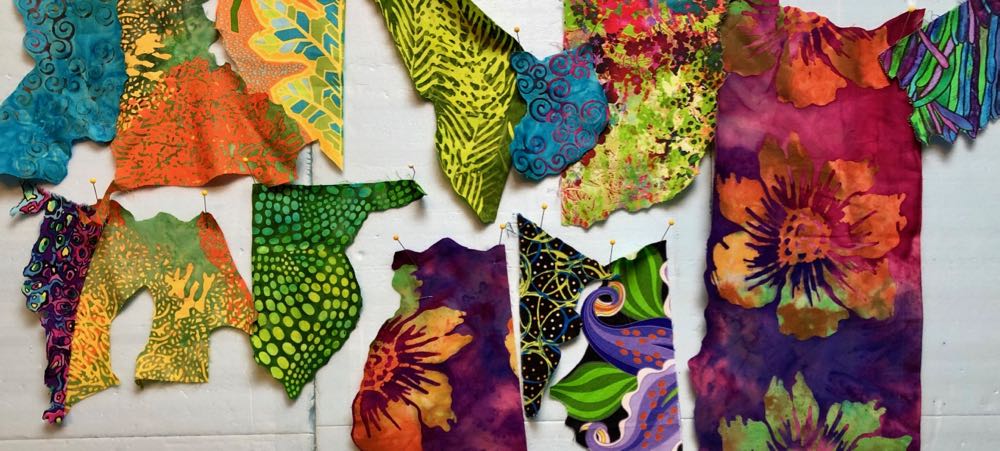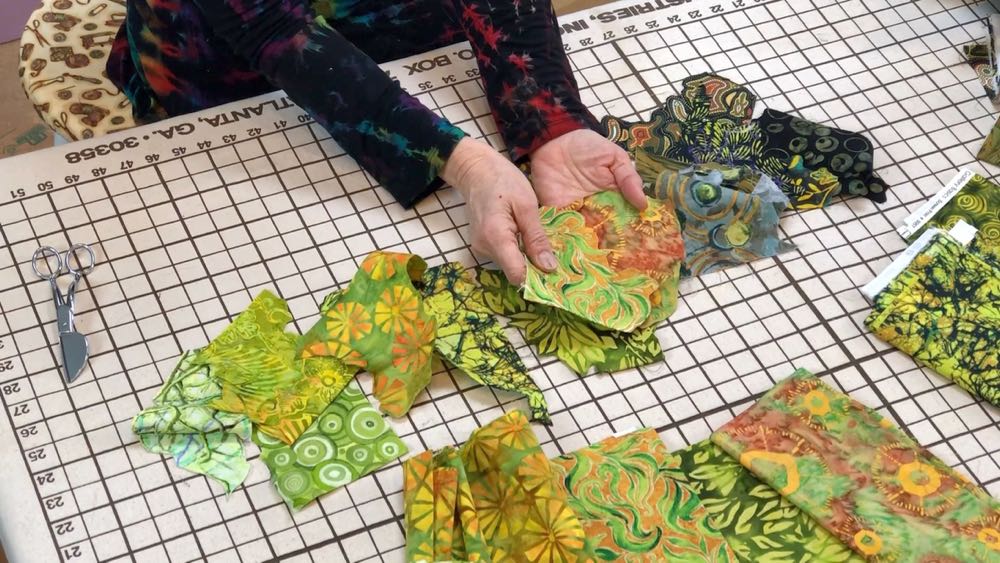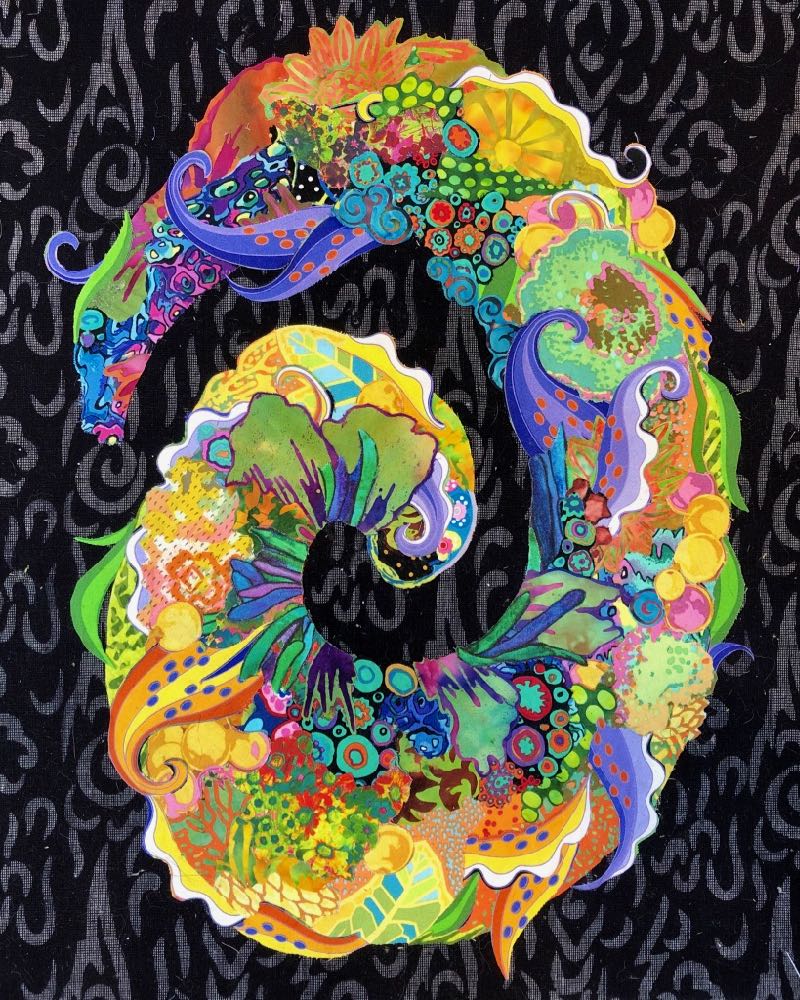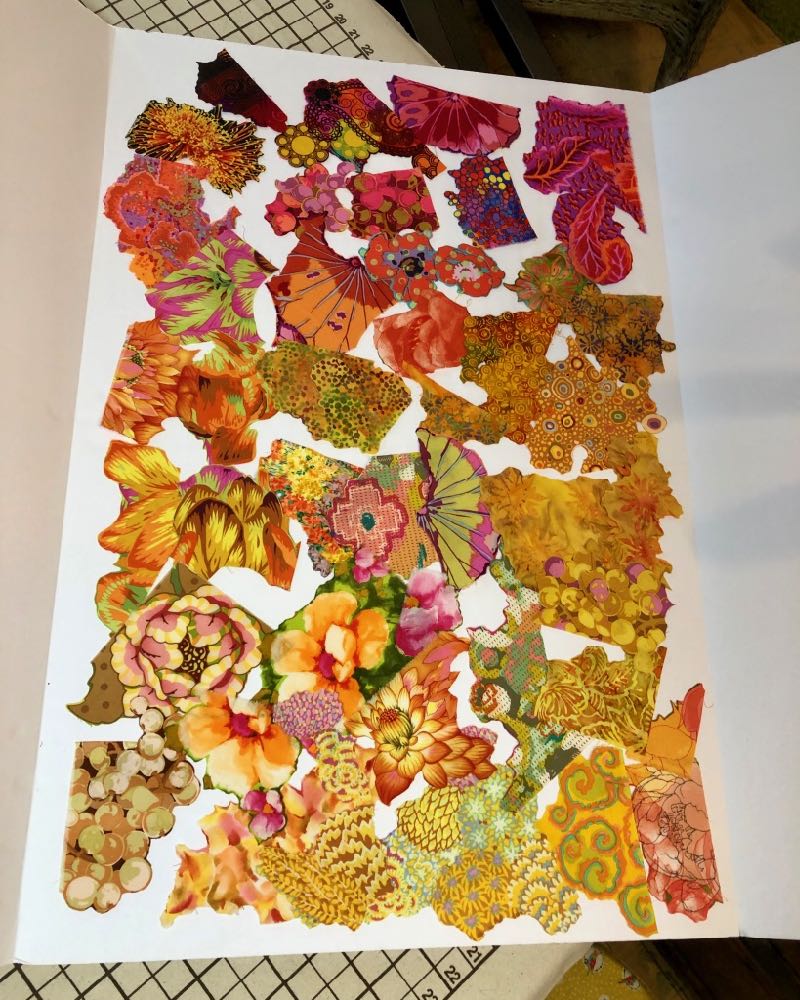Creating a Palette for Fabric Collage: Fabric Collage By the Numbers #5
Tom and I are using part of our summer days to provide you with a sort of DIY Summer Collage Camp—or a Winter Collage Camp for those of you in the Southern Hemisphere. We’re calling it “Fabric Collage By the Numbers,” addressing all the steps of creating a fabric collage quilt. We hope you’ll participate from wherever you are in the world—no travel involved!
Pulling from six and a half years of fabric collage blog posts as reference material, we are delving into that content to give you a summertime lineup that you can follow along with. At the start of this series, there were eight weeks left of summer (not by the calendar but by the very subjective lens of the Maine climate!) so each week we’ll deliver two posts for a total of sixteen in the series—unless we re-discover more relevant posts along the way! The photo above shows a selection of fabrics arranged as a fabric palette and ready to audition on a spiral design, in today’s post following below.
Posts from our Summer Special include; #1—choosing your photo (posted on July 7), #2—choosing a subject (posted on July 9), #3—making a pattern (posted on July 14), #4—how to choose fabric (posted July 16) to eventually hanging your fabric collage on the wall (planned delivery on August 27), we’ll cover each step with at least one previous post.
For instance, just a few weeks ago on July 2, 2022, I published a second post pertaining to creating a fabric palette. This time the fabric selection was exclusively African fabrics—addressing the issue of how to cut a “random” and “organic” edge from bold and large patterned fabrics that often have a gridded pattern. Check out this post if you’re curious on how to accomplish that.
By the way, if learning more ways to work with the African fabric you may have in your stash interests you, you can still purchase a ticket to the Quilt Africa Summit—via recordings from the entire three days of presentations and classes—available now until December 8th, including my slide lecture about using African fabrics in fabric collage. Use this link to visit the Quilt Africa Summit 2022 page, where you will find ticket info to view my lecture as well as all the other presentations and classes. It was a very fun and enlightening few days, I got to meet and interact with new fabric enthusiasts, and watch, listen to, and learn from others—stimulating ideas for my own work. More about the Summit here.
Back to our Summertime Fabric Collage By the Numbers series, you may have read some of these posts before, so they’d be a refresher for you. The information may also be reminiscent of information found in our online learning resource the Fabric Collage Master Class. If so, know that you’re not imagining things. Much of this information is gathered, reorganized and expanded upon in the Master Class. For more information about the Fabric Collage Master Class, click the button below.
Creating a Palette for Fabric Collage
(First published on October 31, 2020)
A painter’s main tool, beside her brushes, is her palette. For each painting, an artist chooses from her countless tubes of paint just the ones she wants for this particular image. She squeezes out a dab of this and a dab of that until she has the entire range of colors and values she wants to use.
I want you to look at your fabric as your palette. Now don’t misunderstand: You may have stacks and stacks of fabric, but that is not your palette. Think of those as your tubes of paint. You have to narrow those choices down. And most importantly, just as you can’t use the paint when it’s still in the tube, you can’t use your fabric when it’s in a huge chunk of a yard or more.
What to do?
When creating the turtle quilt from my Fabric Collage: Sea Turtle eWorkshop, my palette was always close by and was arranged by value, light to dark (see photo at beginning of post). Because my palette was nearby and organized, it was easy to zero in on just the right choice of fabric.
Well, what I’ve been telling my fabric collage students more and more, is to make a fabric palette before they begin their collage. I have them select a range of fabrics. The colors don’t matter as much as the values do. Your subject can be any color you want, but in order to give your subject form you need to have a complete range of values. From the lightest highlight to the darkest shadow, you need a fabric that fills those niches.
Once they’ve selected their fabrics, I have them cut out hand-sized chunks of the fabric, following the prints in the fabric as a guide, NOT cutting directly across and through the print design. Once the pieces are cut out, they’re arranged according to value, from light to dark.
This, then, is the fabric collage palette.
It’s important when creating your palette to avoid cutting your fabrics into similar sized shapes. Create a palette with a variety of shapes by letting the design or print in the fabric dictate where you cut. In this example from my Thursday Night in My Studio Live! presentations, “Is It Drafty in Here? Working in Drafts”, take a look at the variety of shapes included in the palette for my colorful spiral. Organic or irregular cut pieces of fabrics blend together better than those that are cut in a repeated shape. Note how the fabrics in my palette blend together when placed next to each other.
I’ve always kept a palette of fabrics nearby as I worked on a collage, though not always in an organized sort of way. The idea of encouraging my students to pre-cut their palette and organize to values, grew out of a situation in which I was teaching a class but there was a 24-hour delay in having a few students’ patterns enlarged. To occupy their time in a productive way, I had them look at their fabrics and create their palettes. Even though they had to wait until the second day to start placing their cut fabric shapes, they actually made as much or more progress on their collages by the end of that day than many other students in the class.
The usefulness of teaching this way of working was immediately obvious to me.
However.
It’s not easy to convince students that all this cutting into of their perfectly fine un-cut fabrics is a worthwhile effort, when they don’t even know if these fabrics will, in the end, even work in their collages. I understand that it’s a leap-of-faith investment of time to create a palette before starting to collage. And many of my students are simply so excited to get started that they skip ahead of this step. I just know that from what I’ve seen from their experiences with fabric collage, I’m going to emphasize it more and more in the class curriculum.
I’ve always considered fabric collage to be painting with fabric. I have developed the technique to be as immediate as possible, like painting: I avoid the making of templates; I use glue from a bottle rather than fusible adhesive; and I prep my fabrics by creating a palette. These methods all help me concentrate on collaging the image with my pre-cut shapes, rather than interrupting the process by searching through stacks of fabric again and again.
Pre-cutting a palette of fabrics for your fabric collage allows you to audition, place, and easily trim each piece. Try one fabric, reject it, choose another, trim it down, pin in place. Move on to the next open area.
Arranging your palette by value helps you zero in on the fabric you’re looking for. Are you working on a highlight such as the tip of the nose or cheek? You know where your lightest valued fabrics are already. Working on a shadow on the side of your dog’s head? Here are the darkest values of fabrics.
For my Thursday Night in My Studio Live! presentation on creating faces, I demonstrated the portrait exercise above. Notice how I’ve arranged my palette around the design from light to dark. Not only that, but the light fabrics and dark fabrics are placed near the side where they’ll be used, the lights on the left, the darks on the right. The cut shapes don’t get used in their entirety, I end up using sections of each—parts of them here and there. As I do so, the hand-sized pieces get reduced in size, as do the open areas I need to fill.
When you initially create your fabric collage palette, that doesn’t mean you can’t and won’t add to it. A palette of 12 – 15 cuts of fabric is a good number to start with, it gets you going with as little fuss as possible. But you may find as you progress, that you need another fabric color, print, or value to fill a particular niche. That’s fine. It’s expected, even. You’re learning what you need as you move ahead.
I hope creating a palette helps you begin and keep going on your fabric collage journey. I believe it is one of the simplest ways to give yourself a head start on your next project.
I recently began work on a Celestial Portraits Module for the Fabric Collage Master Class Manual. Above are fabrics that I chose for a Sun Face. This is the palette I’ll work with—admittedly I got a little carried away with my initial selection (but I’m really looking forward to working with them). I have placed my palette onto the center section of a tri-fold presentation/display foam board. Below are photos showing how the sides of the board are hinged so that it can be closed up and will protect my fabrics when they’re not in use. I thought this was a particularly clever idea. I mentioned it to Tom noting that my palette would now be safe from my curious studio cat, Djinni: “In case she decides to nap on them, knock them around or, you know, puke on them.” No sooner had I closed the shutters on my palette than Djinni hopped onto the table and hacked up her breakfast onto the folded up board, proving my hypothesis that yes indeed, a foldable palette surface could save my fabric shapes from the cat.



















3 Comments